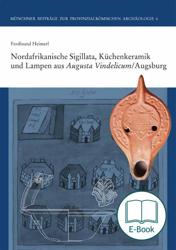This study investigates African Red Slip Ware (ARS), kitchen ware and lamps from Augusta Vindelicum (Augsburg in Bavaria). Products from North and Central Tunisian pottery workshops are dateable from the late 1st to the first half of the 5th century AD. The provenance of North African pottery can be identified by macroscopic and chemical analyses with X-ray fluorescence. In combination with chronologically differentiated maps these analyses aim to better understand both the settlement and economic history of the provincial capital of Raetia. The chronologically important material serves as a reference for the supply of Raetia and cross-regional comparative studies.
This study investigates African Red Slip Ware (ARS), kitchen ware and lamps from Augusta Vindelicum (Augsburg/Bavaria). The aim is to better understand both the settlement and economic history of the provincial capital of Raetia via its pottery assemblage. Analysis of the material offers further information on typology, chronology, provenance and quantity. Ceramic products from North and Central Tunisian pottery production centres are dateable from the late 1st to the first half of the 5th century AD. A selection of ARS and lamp fragments was subjected to chemical analyses by wavelength-dispersive X-ray fluorescence (WD-XRF) to examine provenance and mechanisms of supply. North African cooking ware is represented with only a few fragments that are associated with an influx of people into the province with Mediterranean cooking habits. The relatively high number of lamps in Augusta Vindelicum is attributed to the demand of a wealthy clientele in the provincial capital. Following the section on typology and chronology, the state of research on Late Roman features and small finds from both sides of the Roman town wall of Augsburg is summarized. This forms a basis of discussion for the continuity of settlement and the expansion of Augsburg in Late Antiquity. The distribution of African ceramics in Augsburg is then presented on chronologically differentiated maps. These indicate that there was no reduction in settlement during the 4th and first half of the 5th centuries. The final chapter examines distribution patterns of North African ceramics in Raetia. The quantity and variety of forms in Augsburg stand out in particular within the overall ceramic assemblage of Raetia. This is in part due to continued intensive excavation. It is argued that the large amount of North African ceramics in the provincial capital is evidence for a local demand for high-quality tableware. Furthermore, in contrast to most Raetian sites, Augsburg offers a statistically significant amount of North African ceramics. The chronologically important material is a crucial archaeological source for long-distance trade and the history of Augusta Vindelicum. It also serves as a reference for cross-regional comparative studies.
Das Material aus Augsburg bietet eine sehr gute Vergleichsbasis für die Auswertung afrikanischer Importe in Rätien und die zugehörigen Handelsrouten. Daher diskutiert der Autor das gesamte publizierte Material aus der Provinz und zieht auch epigraphische und schriftliche Quellen heran. Es bestätigt die schon von Anton Höck und durch Mackensen beschriebene Handeslrouten der Mittelmeerwaren, die aus dem nordadriatischen Raum über Trient, das Etschtal und den Reschenpass nach Augsburg führten. (...) Die Publikation von Ferdinand Heimerl bringt einen wichtigen Beitrag zur Handeslgeschichte und zum Studium der Handelsbeziehungen zwischen dem Mittelmeergebiet und den mitteleuropäischen Regionen in der Antike und ist grundlegend für künftige Forschung zur Handels- und Siedlungsgeschichte von Augsburg und Rätien. Es bleibt zu hoffen, dass diese und die anderen hervorragenden Arbeiten der Reihe Münchener Beiträge zur Provinzialrömischen Archäologie als Vorbild für die Aufarbeitung von Importware in andere Provinzen nördlich der Alpen dienen, vor allem auch in Nieder- und Obergermanien.
Von Horacio González Cesteros
In: Bonner Jahrbücher Bd. 25 / 2015
----------------------------------------------------
„Das chronologisch empfindliche Material stellt nicht nur eine wichtige archäologische Primärquelle für die Handels- und Siedlungsgeschichte der Provinzhauptstadt Augusta Vindelicum dar, sondern dient gleichzeitig als aussagekräftiges Referenzmaterial für überregionale Vergleichsstudien“
In:
www.fachbuchkritik.de----------------------------------------------------
„Heimerl’s carefully researched and fully up-to-date study bears testimony to how far our knowledge of African Red Slip, cooking ware and lamps has progressed over recent decades.17 In addition, it contributes in no small way to knowledge of the settlement history and external relations of Augusta Vindelicum and the province of Raetia as a whole. The young scholar has successfully fulfilled the task set before him with an impressive first publication. Much may be expected from him in the future.“
Von Dr. john Lund
In: Journal of Roman Archaeology 29 (2016)
----------------------------------------------------
„Das hier vorliegende Werk kann als überaus gelungene Fortsetzung der Münchener Beiträge zur Provinzialrömischen Archäologie bezeichnet werden. In den letzten Jahren wurden in dieser Reihe wissenschaftlich relevante Funde und Befunde aus römischen Kontexten vorgestellt. Mit den Ausführungen zur Nordafrikanischen Sigillata, Küchenkeramik und den Lampen aus Augusta Vindelicum ist jedem Archäologen, der sich mit nordafrikanischen Importen in Raetien und darüber hinaus beschäftigt, ein wichtiges Werkzeug an die Hand gegeben.“
Von Dr. Martin Auer
In: Bayerische Vorgeschichte 82 (2017)
Ferdinand Heimerl (born in 1989) studied Archaeology of the Roman Provinces, Prehistory and Ancient History at the Ludwig-Maximilians-University Munich and the University of Newcastle upon Tyne (England). He received his Masters degree from the University of Munich in winter semester 2013/14. This monograph comprises a revised version of his Masters dissertation. In addition to numerous excavations in Germany, he took part in several field projects in Austria, Italy, England, Egypt and Libya. He is currently writing his PhD thesis on Roman Bitburg (Rhineland-Palatinate, Germany). 2014 he has been awarded from Ludwig-Maximilians-Universität München for the LMU Forscherpreis für exzellente Studierende.


 Sample
Sample